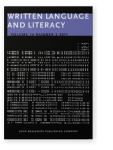Vol. 14:2 (2011) ► pp.275–292
The length hierarchy and the graphematic syllable
Evidence from German and English
Minuscules of the Roman alphabet can be subcategorized into graphemes with length (for example 〈b〉) and graphemes without length (for example 〈o〉). While plosives, which correspond to graphemes with length, occur at the syllable edge, vowels, corresponding to graphemes without length, constitute the syllable core. Based on these observations, a length hierarchy is established in which the feature ‘length’ becomes scalar. This hierarchy operates on graphematic grounds exclusively, thus being independent of phonological properties. Still a length sequencing principle as the ordering principle of the graphematic syllable can be formulated analogous to the phonological sonority sequencing principle. The length sequencing principle may be considered a typological feature to serve further descriptions of different graphematic systems based on the Roman alphabet. Data from German and English will be discussed. Keywords:graphematic syllable; graphotactics; length sequencing principle; length hierarchy; letter shape; sonority
Cited by (8)
Cited by 8 other publications
This list is based on CrossRef data as of 21 july 2024. Please note that it may not be complete. Sources presented here have been supplied by the respective publishers. Any errors therein should be reported to them.
